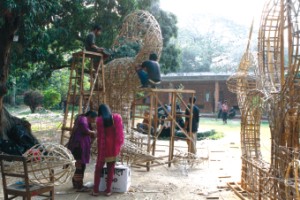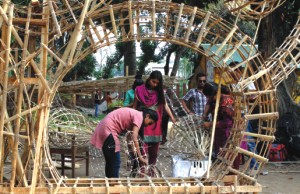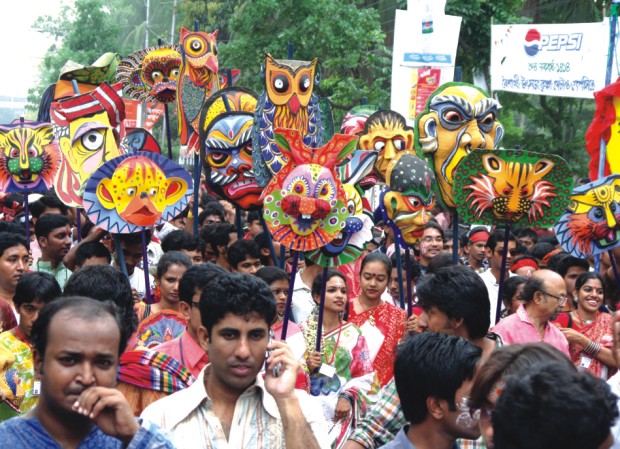| Home - Back Issues - The Team - Contact Us |
 |
| Volume 10 |Issue 15 | April 16, 2011 | |
|
|
Festaval Bengalis' Procession of Joy Mongol Shobhajatra The colourful rally brought out by Charukala students on every Pahela Baishakh reminds Bangladeshis of their rich cultural heritage and symbolises the joy of living. Tamanna Khan
As the century-old sun peers in the eastern sky on April 14, Bangladeshis wake up from their slumber of bygone years, rub off the weariness from their eyes and come out in the streets to greet the first rays of the sun that marks their New Year- Pahela Baishakh. One of the main attractions of this public event is the colourful parade brought out by students of the Faculty of Fine Arts (Charukala). A burst of colours floods the city as the parade starts from Charukala's gates with huge folk motifs of tiger, horse, elephant, owls, pigeons, peacock, parrot and dolls as well as paper masks of varying shapes and colours. The traditional attire of red and white for Pahela Baishakh is sprayed with stark blue, yellow, green, orange and hundred other shades as these paper animals roam the Dhaka University area in their wooden wheels, accompanied by a cheerful mob playing drums and pipes. Though the parade - Mongol Shovajatra- is almost an integral part of the Pahela Baishakh fête of the cities, its history is comparatively new. It is not known whether such colourful processions on occasion of the New Year, used to come out during the Mughal period, when the Bengali calendar was first brought out by the Mughals to keep accounts of tax collection. This parade was absent even during the Pakistani period, when the city version of the Pahela Baishakh festivity - the ritual of welcoming the New Year at Ramna Batamul was started. The Pahela Baishakh celebration of 1965 was a way to protest the suppression of Bengali culture by West Pakistani autocratic military regime. Ironically it took almost two decades for young minds of a different generation in liberated Bangladesh to come up with a different idea for merriment at Pahela Baishakh. This time the idea developed out of frustration from an autocratic regime. "The beginning was at Jessore. There's an art school for children at Jessore, named Charupith which was run by students of Charukala. At that time, during 1988, the universities were closed. There was a historic vacation during Ershad's regime and the universities were closed sine die. So students had gone back to their hometowns. They had nothing to do then. At that time the chaps at Charupith- Mahbub Jamil Shamim, Hironmoy Chandra, Mahbubur Rahman, artists from Dhaka and many others from Charukala, Dhaka brought out a rally from Jessore's Charupith on the Pahela Baishakh of 1988," informs Shishir Bhattyacharya, renowned artist, cartoonist and faculty member of Charukala, Dhaka.
Sitting on the roof-top of the Fine Arts building in the scorching April sun, Shishir, who in 1988 had just joined the faculty as a young teacher, travels back to that time and recounts how that small-town rally soon became an inseparable part of Dhaka's Pahela Baishakh merriment. "In the April of '88 students of Charukala did this in Jessore and they were all very excited about being able to do something new. In the meantime they returned to Dhaka and when on December 29, Zainul Abedin's birth date came, they decided to celebrate it with a lot of fanfare, naming it Zainul Utsab. They already had experience of making large folk motifs to make the rally colourful and their skills made the Zainul Utsab very lively. At that time it was decided that a similar rally would be brought out in the following year's Pahela Baishakh," he says. "The first parade was brought out on the Pahela Baishakh of 1989. The name Mongol Shobhajatra was given at that time at a meeting organised with veterans of the cultural world - Chhayanaut Wahidul Haque, Kamal Lohani, the Director General of Shilpakala, litterateurs, senior artists and other cultural activists. Along with me there were Nisar Ahmed, Moniruzzaman, Rafiqun Nabi, Shammilita Sangskritik Jote, Nasiruddin Yousuff Bachchu. All of us took part in the organisation of the parade," recalls Shishir, who still actively coordinates the rally. Initially, the parade was funded by contributions from the organisers but as time passed and the rally almost became Charukala's patent, the students began to raise fund for it. "We do not get any sponsorship for holding the rally. So the students now sell shora to raise the money for financing the parade," informs Shishir.
Usually the out-going batch of Charukala takes the lead in organising the rally and coordination of the activities prior to the rally. Sitting by the Zainul Gallery in front of a make-shift clothes wall, where junior students are hanging colourful Shoras (earthenware) for sale, Shumi, masters 2nd part student, says, "every student of Charukala takes part in this event. Students from 1st and 2nd years learn the works under our supervision. Then we select their works. Sometimes we (the seniors) as well as the teachers participate in this." Painted shora and other art works, mainly painting, by both teachers and students are put on sale on the Charukala premises from April 1 to April 14. Selection of shora for display and the price is set based on the quality of work. "Special emphasis is given on folk designs as they are becoming extinct nowadays," adds Shumi. Two weeks before the rally, Mohammad Babul Mia and his aides Zahid and Tara are busy building the wooden structure of a large bird on the green lawn of Charukala. He works on contract basis earning Tk 400 daily for making the structures of the motifs with wood and bamboo. While Babul and his helpers are busy at the lawn, fourth year student Chayan, instructs the freshers to stay after class in order to make the large paper masks of Raja and Rani (King and Queen), that bask under the April sun in the classroom veranda. "First we make a model with earth for the paper mask. Then we cover it with polythene and paste brown paper with glue on top of it. Layers of paper have to be pasted to make it strong. The whole process can take two days," explains Chayan. This year they have targeted to complete 120 such masks. The Baishakh Committee of Charukala, headed by the dean of the faculty has already started their preparation since March 27. The busy creative minds inside the institute, spontaneously and cheerfully work from morning till late night before the Bengali New Year to add colours to the lives of others. "Every year, the folk motifs are repeated but sometimes depending on the situation of the country motifs on contemporary issues are also made," says Shishir. That is how the Mongol Shovajatra works - it not only reminds Bengalis of their rich folk heritage but at times through the presence of satirical motifs tells them to cleanse themselves of their past mistakes and failures. Copyright
(R) thedailystar.net 2011 |



